Free Spaces, Free Minds: How Minimalism in the Workplace Can Increase Your Efficiency

Transform Your Workspace
In today’s fast-paced work environment, *clutter* can be a silent killer of productivity. The more distractions around you, the less focused you become. This is where the principles of minimalism step in, transforming your office into a haven of clarity and efficiency.
Understanding Minimalism
Minimalism is not just about possessing fewer belongings; it requires a strategic approach to designing your workplace environment. A minimalistic design emphasizes that clear spaces can lead to clearer thinking. By reducing visual chaos, you create an atmosphere conducive to creativity and concentration. The benefits of a minimalist workspace are significant and can have profound implications on your work performance:
- Increased Focus: A decluttered desk not only looks pleasing but also helps streamline your attention. For instance, prioritizing essential tools like a pen and notepad over countless items frees your mind to absorb more important information.
- Improved Efficiency: Fewer distractions allow for faster completion of tasks. With less clutter vying for your attention, your brain can tackle projects more systematically, potentially reducing the average workday length.
- Stress Reduction: A clean environment promotes a calm mindset. Studies have shown that workers in tidy spaces report lower stress levels, which directly correlates with improved job satisfaction and overall mental health.
The American Workplace
For many in the United States, the office is a second home. The traditional image of a bustling corporate workspace is evolving. Companies are starting to understand that the physical environment can greatly influence employee performance and morale. Firms like Google and Facebook are famous for their creative and open spaces that promote collaboration while maintaining essential areas of tranquility through minimalist designs.
However, adopting minimalism doesn’t just change your environment; it can revolutionize your entire work ethic. As a result, more companies are finding value in promoting a simple yet functional working space. Research indicates that employees who enjoy a decluttered workspace tend to take fewer sick days and are more engaged with their work, making it a win-win for both individuals and organizations.
Are you ready to discover how a minimalist approach can elevate your professional life? Adopting a minimalist philosophy could mean donating or discarding items that no longer serve a purpose. Stay tuned as we explore practical tips to create an efficient workspace that reflects the philosophy of *free spaces, free minds*. These include techniques for organizing your desk, selecting the right color palette, and using intelligent storage solutions to foster an environment that inspires innovation and productivity.
DISCOVER MORE: Click here to learn how mindful living can reshape your life</a
The Impact of Decluttering
One of the foundational elements of minimalism in the workplace is the process of decluttering. This step not only creates a more visually appealing environment but also fosters enhanced cognitive abilities. When you start to remove unnecessary items from your workspace, you may discover a multitude of benefits that go beyond aesthetics. It’s worth considering that the space you inhabit can significantly impact your efficiency and creativity.
Benefits of a Decluttered Workspace
So, what exactly does a decluttered workspace entail? It involves evaluating the items around you and determining which are indispensable to your daily tasks. Embracing this practice can lead to several profound advantages:
- Enhanced Creativity: A clean environment allows the mind to roam freely without the interference of visual distractions. Numerous studies have indicated a direct link between minimalistic surroundings and the generation of innovative ideas. By minimizing clutter, you clear space for ideas to flow and develop.
- Time Efficiency: Searching for misplaced items can absorb significant portions of your day. A streamlined workspace eliminates the need for prolonged searches, allowing you to focus on your tasks. Think about how much time could be saved simply by keeping your workspace organized.
- Better Collaboration: In a minimalistic office setup, communal areas are typically designed with simple furniture and ample space, promoting teamwork and communication. This encourages employees to engage with one another, ultimately leading to more productive outcomes.
Practical Steps to Begin the Transition
The transition to a minimalist workspace doesn’t have to be overwhelming. There’s a plethora of strategies to implement right away, each designed to facilitate a smoother workflow. Here are some practical steps to consider:
- Establish a Zero-Tolerance Policy for Clutter: Commit to keeping only those items that are necessary and useful. This can mean going through your desk drawers, shelves, and even digital files to identify and remove the excess.
- Use Creative Storage Solutions: Invest in multi-functional furniture and organizational tools. For instance, using vertical storage can clear up desk space while keeping essential items within reach.
- Designate Clean-Up Time: Regularly schedule times throughout the week to tidy up your workspace. Even five minutes a day can lead to significant reductions in clutter.
Embracing minimalism in the workplace leads to a more intentional approach to how we engage with our environments. By systematically evaluating our workspaces and taking proactive steps to declutter, we promote not just a clearer working space, but also a clearer mindset. This is a practice increasingly adopted by forward-thinking organizations across the nation, setting them up for long-term success.
Free Spaces: The Backbone of Increased Efficiency
As we delve deeper into the world of minimalism in the workplace, it becomes clear that free spaces are not just a trend; they are essential components of a productive environment. By designating areas with minimal distractions, companies can facilitate better focus and creativity. Studies show that clutter not only affects our ability to concentrate but also increases stress levels, which can have a direct impact on our efficiency.Consider the open office model, which promotes collaboration while maintaining minimalistic design principles. This setup allows for easy movement and communication among team members, fostering a culture of innovation. Additionally, incorporating natural elements, such as plants or natural lighting, has been linked to improved mood and cognitive function. The crucial aspect is finding the balance between open space and personal zones, ensuring that each employee feels comfortable while retaining the benefits of minimalism.
Free Minds: The Mental Clarity Factor
Minimalism extends beyond physical space and into our cognitive realms. When employees are surrounded by less visual chaos, their minds become free to think creatively and make better decisions. Simplifying tasks and honing in on essential functions can reduce the overwhelm often felt in a busy workplace.Research indicates that lessening the mental load by eliminating unnecessary tasks can lead to heightened productivity. By allowing your team the capacity to focus solely on what matters, you’re inviting them to engage more deeply with their work. This mental clarity often leads to innovative solutions that might have otherwise been overlooked in a high-stress environment filled with distractions.Thus, embracing minimalism in the workplace not only improves the aesthetic value of workspaces but also cultivates a mindset geared towards efficiency and innovation. By prioritizing both physical and mental space, organizations can create a powerful synergy that propels their teams forward in an increasingly competitive landscape.
| Advantage | Description |
|---|---|
| Enhanced Focus | Minimalist environments reduce distractions, enabling better concentration on tasks. |
| Increased Creativity | Free spaces foster a mindset that encourages innovative thinking and problem-solving. |
DISCOVER MORE: Click here to learn about digitalization’s impact on personal clutter
Fostering a Minimalist Mindset
While decluttering is a significant step towards minimalism in the workplace, it’s merely the beginning. The journey towards a minimalist environment and mindset can lead to profound transformations in productivity, well-being, and overall job satisfaction. Adopting a minimalist mindset extends beyond physical space; it involves reassessing priorities, responsibilities, and even digital interactions.
The Influence of Intention
Central to a minimalist approach is the principle of intention. Intentionally organizing your workspace and tasks aligns your daily functions with your core values and objectives. A clear understanding of what truly matters helps eliminate distractions and extraneous obligations. Research suggests that adopting such an intentional approach can enhance focus, as workers report feeling less overwhelmed when they concentrate solely on the tasks that genuinely contribute to their goals.
Digital Minimalism and its Effects
In today’s fast-paced digital world, employees often grapple with digital clutter just as much as physical clutter. Emails, notifications, and endless streaming of information can create an overwhelming environment that hinders productivity. Implementing principles of digital minimalism can result in significant efficiency gains. Consider these practical strategies:
- Limit Email Notifications: Establish specific times for checking emails instead of being continually bombarded with notifications. This method allows for periods of uninterrupted work, enabling deeper focus on ongoing projects.
- Organize Digital Files: Create a streamlined filing system where documents are categorized and labeled clearly, akin to physical organizational systems. This can drastically reduce the time spent searching for necessary files.
- Declutter Your Digital Space: Unsubscribe from non-essential newsletters and delete unnecessary applications. Reducing the digital noise can help you regain control over your time and attention.
Creating a Culture of Minimalism
Institutions that embrace minimalism not only foster individual productivity but also cultivate a work culture centered on simplicity and efficiency. Notable companies like Basecamp and Buffer have integrated minimalist principles into their core philosophies, promoting flexible and straightforward work practices. Their commitment to streamlined processes reveals significant results, from improved employee morale to increased efficiency.
Leaders play a crucial role in establishing a minimalist culture. By modeling these principles themselves—such as maintaining organization in shared spaces and encouraging transparent communication—managers can influence employees to follow suit. Additionally, implementing open discussions on prioritizing tasks and reducing unnecessary meetings promotes a shared understanding of collective goals.
Adopting Mindfulness Practices
Incorporating mindfulness practices alongside minimalism can significantly enhance productivity. Mindfulness encourages awareness and presence, reducing stress and reactivity. Simple practices, such as daily meditation or focused breathing exercises during the workday, can lead to a clearer mind and a reduced sense of overwhelm. Research from Harvard indicates that mindfulness can not only enhance focus but also improve overall job satisfaction, creating a more harmonious workspace.
In combination, intentional organization, digital decluttering, cultural shifts, and mindfulness practices create a comprehensive approach to minimalism in the workplace. Engaging in these practices may form the foundation for a more efficient, productive, and satisfying work environment, reflecting a growing trend towards embracing simplicity in various aspects of life.
DISCOVER MORE: Click here to enhance your productivity
Conclusion: Embracing Minimalism for Enhanced Productivity
As we’ve explored, the concept of minimalism in the workplace transcends simple decluttering, evolving into a holistic mindset that promotes efficiency and productivity on multiple levels. By intentionally organizing physical spaces and reassessing digital interactions, employees can create environments that reflect their core values and mitigate the overwhelming presence of extraneous distractions. The rise of digital minimalism invites a reevaluation of our digital habits, encouraging focused work periods and streamlined communication that ultimately contribute to enhanced concentration.
Moreover, fostering a culture of minimalism within organizations not only benefits individual productivity but also strengthens team dynamics and collaboration. Leading by example, managers can cultivate environments where simplicity is prioritized, opening the door to improved employee morale and shared goals.
Incorporating mindfulness practices alongside minimalist principles creates a comprehensive approach that supports mental clarity, lower stress levels, and greater job satisfaction. This alignment between organization and well-being paves the way for not just increased efficiency but also a more enjoyable work experience.
As businesses navigate the complexities of modern work, embracing minimalism can lead to transformative results. The emerging evidence in favor of streamlined methodologies reinforces the notion that, in a world teeming with information and demands, free spaces foster free minds. By committing to a minimalist strategy, organizations can unlock the potential of their workforce, leading to sustainable growth and innovative outcomes. In a time where both mental health and productivity are crucial, minimalism may well be the answer to achieving balance and excellence in the workplace.



